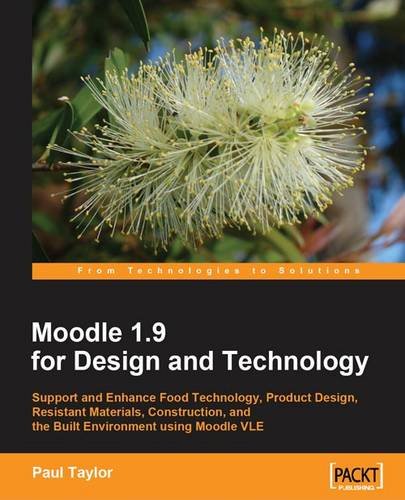(Ebook) Moodle 1.9 for Design and Technology by Paul Taylor ISBN 9781849511001, 1849511004
Support and Enhance Food Technology, Product Design, Resistant Materials, Construction, and the Built Environment using Moodle VLE Customize your coursesCreate a course for each of the key areas of Design and Technology and add material to themSupport and assess the progress of the students who are enrolled in the courseUse Moodle's detailed and sophisticated gradebook to assess your students' learning progress in activities from assignments to offline activitiesCreate Moodle resources for kinesthetic learners by using media-rich content such as videos and audio sequencesIn DetailEducators use the Moodle web application to create effective online learning sites. Creating such learning environments that suit Design and Technology subjects requires understanding and implementation of both basic and advanced Moodle features.This book takes a detailed look at Moodle features with examples of how to fully support the Design and Technology curricula using Moodle. It will guide you to incorporate specific modules and blocks to enhance learning as well as allow detailed tracking of performance by using formative and summative assessment tools with ease.We start with setting up a very basic Moodle course for Design and Technology, and then set up some basic resources and some interactive material. You will customize your own courses and create a course for each of the key areas of the DT subjects and add material to them. We will create some basic reporting and assessment tools and enhance the look of the course. We will use Moodle's detailed and sophisticated gradebook to assess your student s ' learning progress in activities from an assignment to an offline activity. Then we will support students in designing a product or trying a new recipe in food technology in market research to find out exactly what the public wants in relation to their product, by designing a questionnaire. We will allow product design or resistant material students use the HTML features of the questionnaire module to incorporate images into the questions to make it clearer to respondents what it is they are trying to make and sell.We will allow students in construction to gather and organize their research material in a great deal of detail and also allow them to better understand their target market and the materials used in their construction through detailed questioning. We will allow food technology students to discuss and receive constructive feedback on food products that contribute to health issues that will enable them to make informed decisions and therefore better quality products. Then we explore several components within Moodle's core functionality and some third-party sources to display the progress of the student's work and development. We then have an overview of the different design portfolios available. Finally we look at additional ways to enhance the teaching and learning of D & T with Moodle using third-party modules and add-ons.A hands-on tutorial for Design and Technology teachers showing them how to use Moodle to compose their lessons and engage their studentsWhat you will learn from this book Help your students to set up and organize their own database for Materials research or a specific database for food technology using the standard database module in MoodleDisplay the progress of your students' work and development with several Moodle components such as forums, blogs, galleries, wikis, and some third-party sourcesAllow students to store, organize, and share their work with each other by using Moodle Portfolios such as Exabis, MyStuff, and MaharaDesign and create glossaries and add entries specifically for design and technologyAllow students to map out their ideas using a basic interface to link and label items on the screen using an add-on called MindmapAssess your students' progress by designing quizzes that are conveniently linked to the students' gradebookDesign questionnaires and analyze their results and add feedback module and customize them to retain anonymityGive your students an opportunity to use Moodle to present their designs and ideas to a huge audience and gain invaluable feedback by using an interactive tool-DimDimCreate a library of resources for students to interact with using applications such as myUdutu and add-ons such as NoodleCreate a detailed framework with Moodle tools that allow you to chart students progress and offer them constructive feedback through reflective practice and achievable targetsCreate an electronic portfolio for Product design students that they can use to gather and organize their electronic materials ApproachThis book has real-world samples of how to solve problems related to Design and Technology and offers tips on how to enhance the use of Moodle to get the most out of the subject. Worked examples will act as a base from which to build complex and exciting courses for students in all age ranges and abilities.Who this book is written forIf you are a Design & Technology teacher, teaching assistant, head of department, SMT, or IT technician in school and would like to use Moodle to design, create, or administer a VLE for Design and Technology, this book is for you. You need to know the basics of Moodle for teaching and learning and should have some experience with Design and Technology.
*Free conversion of into popular formats such as PDF, DOCX, DOC, AZW, EPUB, and MOBI after payment.


